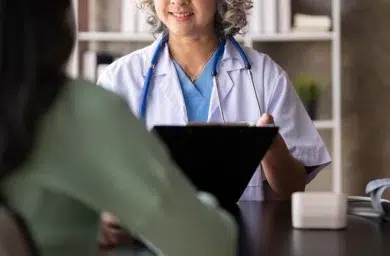March is Endometriosis Awareness Month! This condition impacts over 10% of women in reproductive age, and usually involves severe pains, can lead to infertility, and affects daily activities.
Endometriosis carries a terrible stigma that it is an “invisible illness”. Although it may be difficult to spot or explain the signs of endometriosis or the debilitating pain that women with endometriosis may experience, it is important to raise awareness about this disease that affects 1 in 10 women.
By sharing with you some of the basics of what endometriosis is, and what we can do for our patients who suffer from it, we can slowly but surely advocate and inform women about this fairly common women’s health issue.
Perhaps many of you have heard of endometriosis, but do not know what it is. For those of you in this category, let me explain. Endometriosis is a condition in which the tissue that normally lines the inner part of the uterus is found not only in the uterus but also in different parts of the body (see illustration below). This is sometimes referred to as ectopic (misplaced) tissue. Because this tissue is the same tissue found in the uterus it responds to the female hormone cycle. As you can imagine, because this tissue reacts to female hormones, the endometriosis symptoms can follow a cyclical pattern as well.

The associated symptoms of endometriosis are different for different women, and usually depend on where the extra tissue is located. The most common endometriosis symptoms include:
- Abdominal and pelvic pain
- Extremely painful periods
- Heavy periods
- Pain during intercourse
- Fertility problems
- Pain with restroom use
To definitively diagnose endometriosis, women must complete a biopsy in order to visualize the misplaced tissue.
Understandably, this can seem like an invasive operation, but at our women’s health clinic, we do our best to piece the diagnosis together in a timely manner, hoping to achieve this in a comfortable setting for our patient. Based on how the patient presents to us in the clinic, we may suggest that an in-office vaginal ultrasound or laparoscopy to be carried out to ensure that we don’t overlook other issues or complications that could be contributing to the patient’s endometriosis symptoms.
As we mentioned earlier, the diagnosis process can be very challenging because each patient with endometriosis may present slightly different, depending on where the misplaced uterine tissue may be in their individual bodies. If you are facing, or think you may have, endometriosis it is best to see your gynecologist sooner rather than later. In fact, many women with endometriosis- or those who are susceptible to the disease- have spent several years searching for the cause of their pain or infertility issues before receiving a diagnosis of endometriosis. That is why women should not prolong their pain, symptoms, or diagnosis because this prevents them from receiving the adequate attention and treatment they need.
Once a diagnosis has been made, we can treat the endometriosis medically or surgically. When we treat it medically we treat the endometriosis pain with NSAIDs. In other words, we try to stop all hormone signals to the uterine tissue. NSAID medications will not only affect the misplaced tissue, but also the tissue that is found in its proper place, the uterus. This medication, in a way, causes medically-induced menopause by halting the production of estrogen and progesterone hormones. In this method, patients tend to have menopause-like side effects.
On the other hand, if surgery is deemed the best method for treating endometriosis, the goal is to remove the tissue in one way or another. This gynecological surgery is called Endometrial Ablation and is recommended for women who are premenopausal and have completed childbearing. In some cases, the tissue is burned, thereby killing the misplaced cells; and in other cases the lining of the uterus is surgically removed.
For more information about endometriosis, contact your San Antonio OB/GYN today at (210)222-2694!
If you are looking for more information about the diagnosis and treatment of endometriosis because you believe you may have this condition, please contact our office to set up an appointment with Dr. Bhatia. We look forward to helping you understand your endometriosis and what your next steps will be to maintain the active lifestyle that you enjoy.
6



